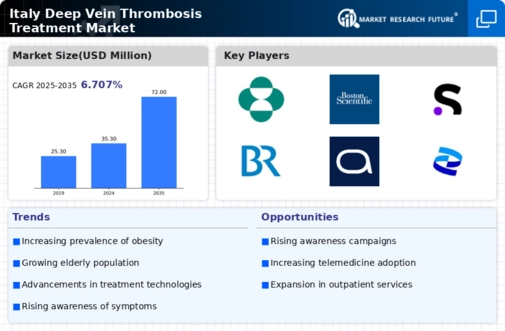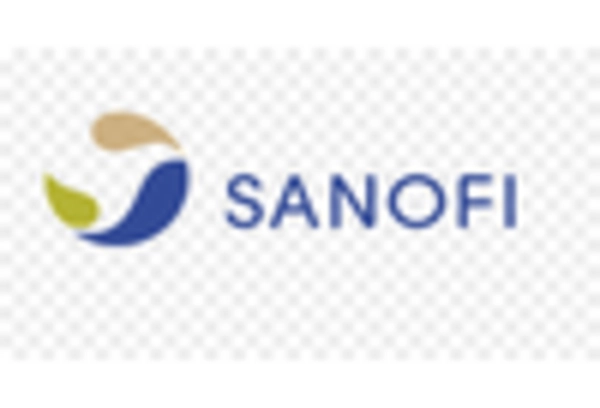Rising Incidence of DVT Cases
The increasing incidence of deep vein thrombosis (DVT) cases in Italy is a primary driver for the deep vein-thrombosis-treatment market. Factors such as an aging population, sedentary lifestyles, and obesity contribute to this rise. According to recent health statistics, the prevalence of DVT in Italy is estimated to be around 1-2 % of the adult population, which translates to approximately 600,000 to 1,200,000 cases. This growing patient pool necessitates enhanced treatment options and healthcare services, thereby propelling market growth. Furthermore, the awareness of DVT complications, such as pulmonary embolism, is leading to more patients seeking treatment, which further stimulates the demand for innovative therapies and interventions in the deep vein-thrombosis-treatment market.
Growing Awareness and Education
There is a notable increase in awareness and education regarding deep vein thrombosis among both healthcare professionals and the general public in Italy. Campaigns aimed at educating individuals about the risk factors, symptoms, and preventive measures associated with DVT are becoming more prevalent. This heightened awareness is likely to lead to earlier diagnosis and treatment, which is essential for improving patient outcomes. As a result, the demand for effective treatment options in the deep vein-thrombosis-treatment market is expected to rise. Furthermore, healthcare providers are increasingly incorporating DVT education into their practice, which may contribute to a more informed patient population and ultimately drive market growth.
Increased Healthcare Expenditure
The rise in healthcare expenditure in Italy is a crucial driver for the deep vein-thrombosis-treatment market. The Italian government has been investing more in healthcare infrastructure and services, which includes funding for DVT treatment and prevention programs. In 2025, healthcare spending is expected to reach approximately €200 billion, reflecting a growth rate of around 4 % annually. This increase in funding allows for better access to advanced treatment options and enhances the overall quality of care for DVT patients. Moreover, as healthcare policies evolve to prioritize chronic disease management, the deep vein-thrombosis-treatment market is likely to benefit from increased resources allocated to research and development of new therapies.
Regulatory Support for New Treatments
Regulatory support for the approval of new treatments is a significant driver for the deep vein-thrombosis-treatment market. The Italian Medicines Agency (AIFA) has been actively facilitating the approval process for innovative therapies, which encourages pharmaceutical companies to invest in research and development. This supportive regulatory environment is likely to lead to the introduction of new anticoagulants and other therapeutic options in the market. As new treatments become available, they may offer improved efficacy and safety profiles, thereby attracting more patients and healthcare providers. The anticipated increase in treatment options is expected to enhance competition within the deep vein-thrombosis-treatment market, ultimately benefiting patients through better care and outcomes.
Technological Innovations in Treatment
Technological advancements in medical devices and treatment methodologies are significantly influencing the deep vein-thrombosis-treatment market. Innovations such as minimally invasive procedures, advanced imaging techniques, and novel anticoagulants are enhancing treatment efficacy and patient outcomes. For instance, the introduction of catheter-directed thrombolysis and mechanical thrombectomy has revolutionized the management of DVT. The market for these advanced treatment options is projected to grow at a CAGR of approximately 6-8 % over the next few years. Additionally, the integration of telemedicine and digital health solutions is improving patient monitoring and adherence to treatment protocols, thereby expanding the reach and effectiveness of DVT therapies in Italy.

















Leave a Comment